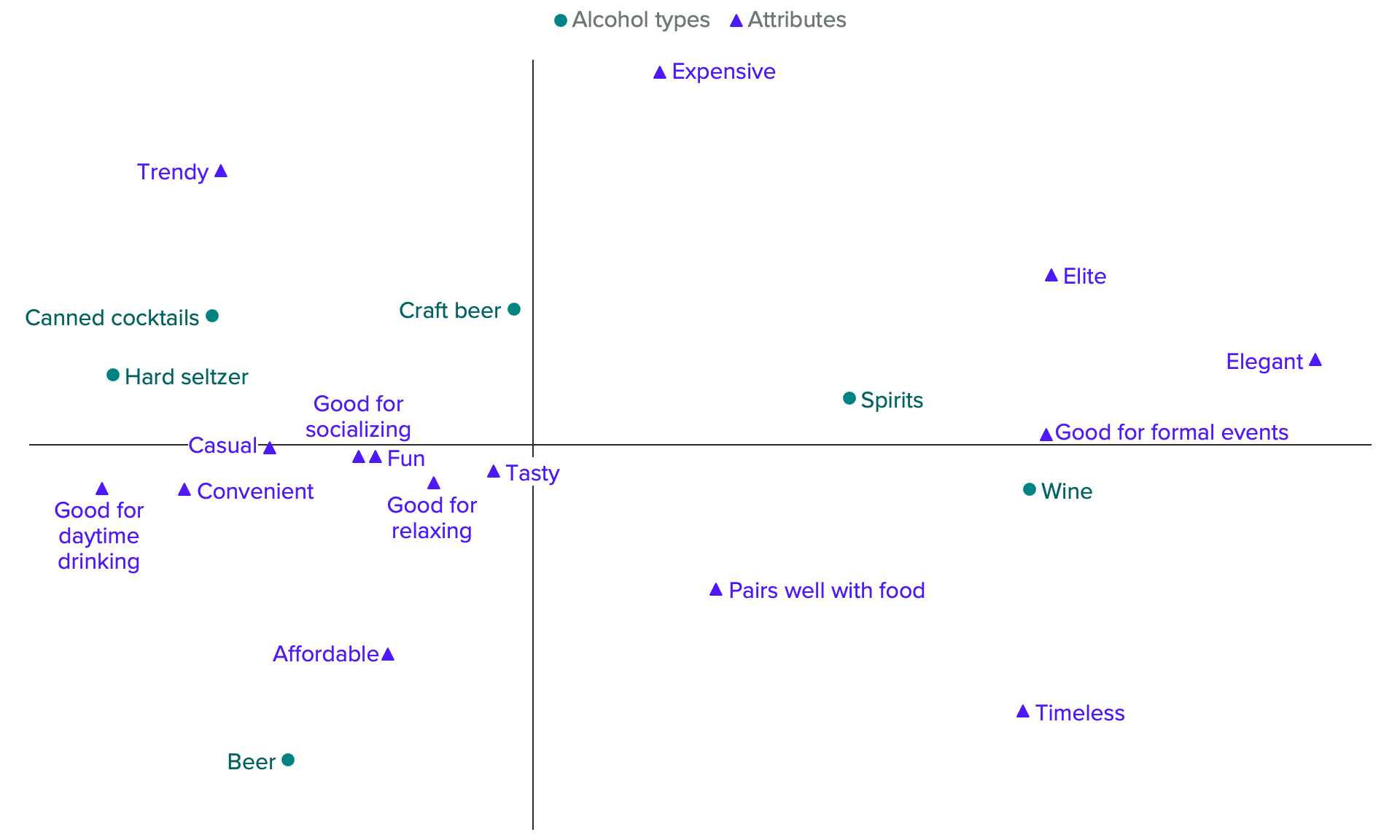How Consumers Differentiate Adult Beverage Categories

A complex, competitive landscape makes it essential for adult beverage brands to better understand what characteristics set different beverage types apart in consumers’ minds. These nuances, depicted in a correspondence map, can help inform strategic positioning and portfolio management.
Adult beverage companies are navigating a complex era of change. From fluctuating demand precipitated by the pandemic to the expansion of new products to better suit changing tastes and occasions, the adult beverage landscape is evolving faster than ever before.
Millennials, it seems, are at the helm of this change. Ever interested in exploring, learning and broadening their experiences, these consumers are less beholden to cultural norms about what to drink and when. As the generation that drinks the most frequently, millennials are blurring the lines between categories, and they are more likely than their older counterparts to drink more types of alcohol on a monthly basis.
To help brands navigate this changing landscape, Morning Consult conducted a correspondence analysis to better understand what truly differentiates categories of adult beverages.
Correspondence maps show in one chart what would otherwise take many: how similar certain categories (in this case, adult beverage types) are to one another in consumers’ minds across many attributes, how closely they are associated with certain attributes and where there is white space for brands to differentiate themselves further.
There is a push and pull to the connection between attributes and categories that leads to their arrangement across the map. The farther away categories are from other categories, or the farther away the attributes are from other attributes, the more differentiated the categories or differentiating the attributes. The angle between each category, attribute and the origin of the map (the intersection of the x and y axes) shows how closely consumers connect the category and attribute, with smaller angles indicating a closer correspondence. For example, wine and spirits are differentiated from other categories on the attribute of being good for formal events, given the small angle between each beverage type, the origin and this attribute.
The map shows a divide between the long-established categories of wine, spirits and beer and newer-to-market drinks like canned cocktails, hard seltzer and craft beer. It also reveals insights about the positioning of these latter categories in relation to one another.

Key findings on category perceptions within adult beverage
No single adult beverage category is differentiated by being “fun” or “tasty.” Weekly drinkers tend to agree that beverages from any category can be good for socializing and relaxing, fun, and tasty (although hard seltzer trails on the last one). These attributes, clustered around the origin, are not differentiated between categories. In other words, consumers seeking any of these attributes don’t consistently select one type of beverage over another.
Brands within these categories may find further differentiation — for example, a specific type of beer could be viewed as being more or less fun than another beer — but companies should note that even when brands are differentiated on these attributes among their direct competitors, they may still be competing with other categories for consumers’ consideration.
Wine stands alone. Consumers associate this long-established category with timelessness and pairing well with food. Alongside spirits, wine is also considered more elegant and better for formal events than drinks on the trendier end of the spectrum.
Adult beverage companies can lean into these distinctions in portfolio planning to make sure they have beverages across the trendy-to-classic and formal-to-casual spectrums.
Hard seltzers and canned cocktails are interchangeable in consumers’ minds. Many of these products currently on the market are relatively indistinguishable to consumers; as such, the two categories occupy a similar placement on the map. Weekly drinkers associate both categories with being trendy and — along with beer — casual, convenient and good for daytime drinking. Consumers were 8 percentage points more likely to agree that canned cocktails are tasty, though.
This suggests brands can expect drinking occasions for the growing ready-to-drink canned cocktail category to compete with hard seltzer, and maybe even craft beer, as opposed to spirits, even though many of them are spirits-based.
Beer owns affordability. However, this attribute plays out differently across different income levels. Those in the middle and high income ranges were more likely than those in households making less than $50,000 annually to say that both beer and wine are affordable.
This association between beer and affordability could prove important amid ongoing inflation in food & beverage and suggests the beer category may stand to win more purchases.
Hard seltzer shares many similarities with beer. “Casual,” “convenient” and “good for daytime drinking” are attributes shared between beer and hard seltzer (as well as canned cocktails). This helps to explain the growth of hard seltzer over the last several years at the expense of beer. Beer is still considered more timeless and better for pairing with food than hard seltzer, though wine more strongly owns that association.
This correspondence map will continue to shift as the adult beverage landscape evolves. Canned or ready-to-drink cocktails, in particular, will show movement as consumers become more familiar with these offerings. In the meantime, brands should lean into the spaces their categories own when positioning against the broader adult beverage competitive landscape and use custom research to better understand their positioning relative to the brands and attributes within their category.
Emily Moquin previously worked at Morning Consult as a lead food & beverage analyst.